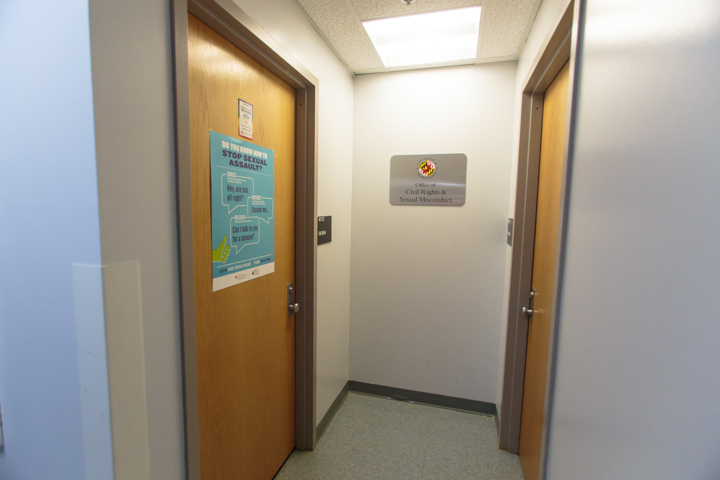While the University of Maryland expelled a record number of students for sexual assault during the 2015-16 academic year, some students received suspensions for the same violation.
Changes in sexual misconduct investigation procedure led to inconsistent punishments for students found responsible for committing Sexual Assault I, which is considered any type of non-consensual penetration.
Four students were expelled for Sexual Assault I in the 2015-16 academic year though three students who were found responsible for the same offense received a more lax sanction, according to the second annual Student Sexual Misconduct Report. Each was suspended and one also completed a required educational and writing assignment. Typically, suspended students must complete a rehabilitation measure and reapply before returning, said Keira Martone, the assistant director of the Department of Resident Life for Student Conduct.
Between May and October 2015, a Standing Review Committee — a group of five trained students, staff and faculty that changes for each case -— helped determine responsibility and sanctions alongside the school officials, but this left room for inconsistencies, said Title IX Officer Catherine Carroll.
“It’s like having a different jury every time; you could have similar facts and inconsistencies in outcomes,” Carroll said. “We decided to be more consistent and more fair — more of a due process lens — and the person deciding sanctions should be the one with the most knowledge and experience.”
Now, once Carroll and the Title IX office complete an investigation, the SRC determines whether a violation of sexual misconduct policy occurred.
If a student is found responsible for a policy violation, the case is referred to the Office of Student Conduct or the Department of Resident Life’s Office of Rights and Responsibilities. Student Conduct Director Andrea Goodwin or Martone determine the final sanction.
Relevant case factors, as well as recommendations from staff members, the complainant or the respondent, play a hand in sanctioning, Goodwin said. Sometimes, for example, a complainant might know the respondent and doesn’t want them to face severe punishment, and these wishes are taken into account.
For Sexual Assault I cases, sanctions usually involve temporary or permanent dismissal from this university, Goodwin said. But for harassment or Sexual Assault II cases, punishment could be a housing probation coupled with a writing assignment.
“I’ve had a case where someone was suspended, sought therapy and made a donation to a rape crisis center, and then came back and said, ‘I didn’t understand why I did what I did until I went through this process, and I’m a different person,'” Goodwin said. “I spend a lot of time with respondents trying to understand where they’re coming from and how much I believe they can learn.”
A former student at this university filed a federal lawsuit Sept. 30 against Carroll and university President Wallace Loh, among other administrators, seeking $5 million and claiming he was wrongfully expelled after this university found him responsible for sexually assaulting a woman in on-campus housing.
There were a total of 66 sexual misconduct complaints issued during the 2015-16 academic year. The office fully investigated 26 complaints, including 16 Sexual Assault I cases. It also saw seven Sexual Assault II cases, defined as unwanted intimate touching; four relationship violence cases; and one sexual intimidation case. Some cases involved multiple types of sexual misconduct.
Reports, complaints and investigations all experienced notable increases between the 2014-15 and 2015-16 academic years. Reports jumped 64 percent, complaints rose by 38 percent and investigations climbed by 44 percent.
“We want to see more complaints and reporting so more students get the resources they need,” Carroll said. “There’s a risk of suffering if students aren’t reporting. But once you drill down into what’s happening with each case, most people don’t want to go forward; they just want help and support.”
When investigating these cases, this university aims to reach completion and resolution within 60 business days. Frequently, the process takes twice as long.
“These are complicated cases,” Carroll said. “We can’t compromise the quality of the investigations, so they’re going to take longer.”
To address this holdup, the office is planning to add additional resources and staff, including a deputy director, Goodwin said. This university also announced Oct. 18 its intention to create six new positions — four in the Title IX office and two in the CARE to Stop Violence office — to assist with investigations.
The Student Government Association voted in September in favor of a proposal to add a $34 annual student fee to fund the Title IX office, but it was later withdrawn.
Twenty-six complainants received academic accommodations last academic year as an interim measure to protect their safety and well-being. Twenty-four no-contact orders — where an individual is told not to have verbal, electronic, written or third-party communication with another person — were issued. The no-contact orders were mutual, meaning both the victims and perpetrators were told not to communicate with each other, Carroll said.
Five students received housing accommodations, which could include changing where they live on the campus, she added.
Some students don’t want to open investigations into their assault or harassment cases, but even without undergoing this part of the process, victims can still get help from this university. “Sometimes people miss that,” Carroll said.
“We’re obligated to investigate and hold people accountable and make sure our campus is safe … but that shouldn’t eclipse the piece that we spend most of our time on, which is supporting students,” she said. “That’s really the picture, and that’s really the story, and that’s the importance of Title IX.”






